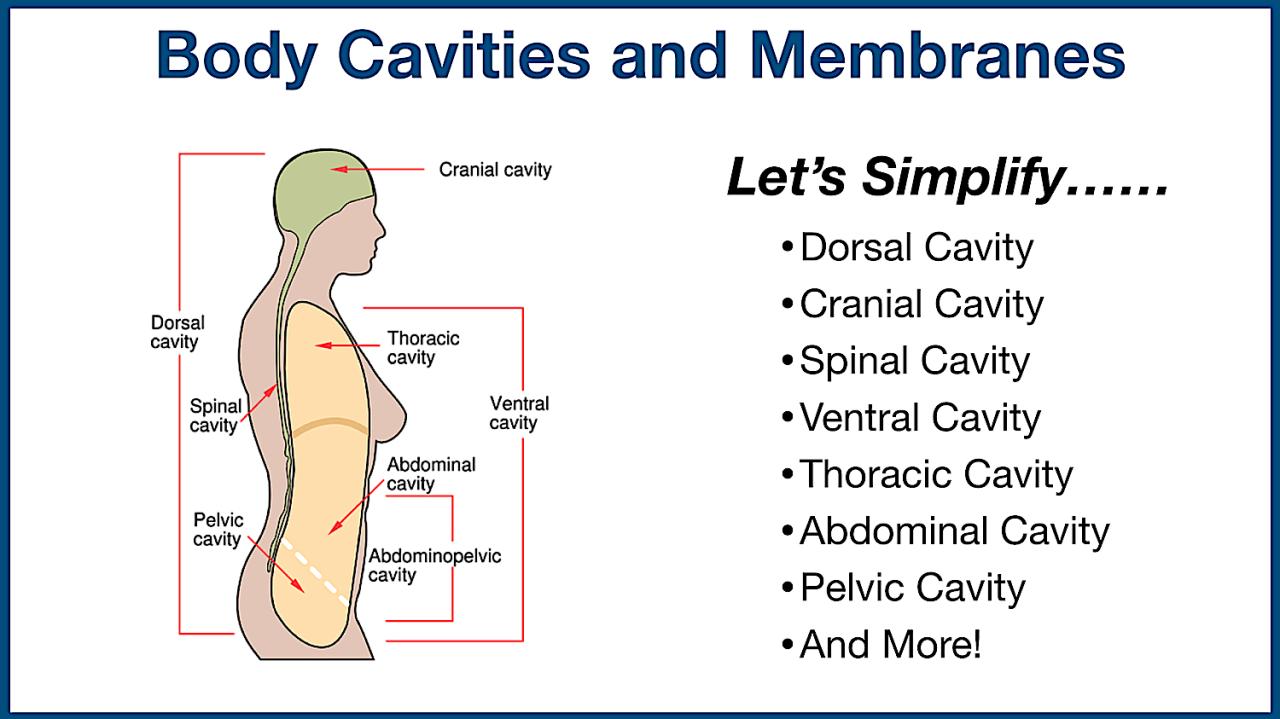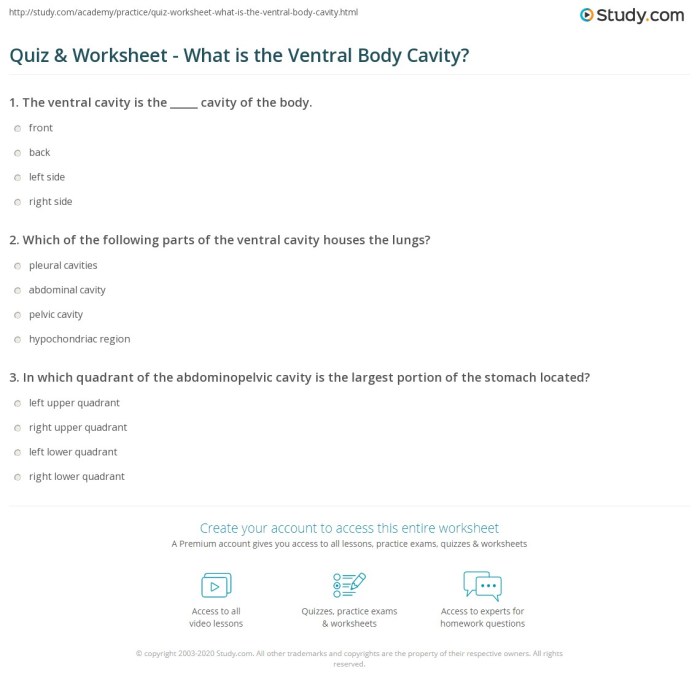Body cavities practice worksheet answers – Delve into the realm of body cavities with our comprehensive practice worksheet answers. This guide will illuminate the intricacies of these anatomical compartments, providing a profound understanding of their structure, functions, and significance.
Our meticulously crafted table categorizes body cavities based on their location, contained organs, and essential functions. We explore the protective role of the dorsal body cavity and delve into the subdivisions of the ventral body cavity, highlighting the distinctions between the thoracic and abdominopelvic cavities.
Body Cavities Practice Worksheet Answers

The body cavities are the internal spaces of the body that contain and protect the internal organs. There are two main body cavities: the dorsal body cavity and the ventral body cavity.
The dorsal body cavity is located on the back of the body and contains the brain and spinal cord. The ventral body cavity is located on the front of the body and contains the heart, lungs, stomach, intestines, and other organs.
| Cavity Name | Location | Organs Contained | Functions |
|---|---|---|---|
| Dorsal Body Cavity | Back of the body | Brain, spinal cord | Protection of the brain and spinal cord |
| Ventral Body Cavity | Front of the body | Heart, lungs, stomach, intestines, other organs | Protection of the internal organs |
Dorsal Body Cavity

The dorsal body cavity is divided into two main divisions: the cranial cavity and the spinal cavity.
The cranial cavity contains the brain and is located within the skull. The spinal cavity contains the spinal cord and is located within the vertebral column.
- Cranial cavity:Contains the brain
- Spinal cavity:Contains the spinal cord
The dorsal body cavity protects the brain and spinal cord from injury.
Ventral Body Cavity: Body Cavities Practice Worksheet Answers

The ventral body cavity is divided into two subdivisions: the thoracic cavity and the abdominopelvic cavity.
| Subdivision Name | Organs Contained | Functions |
|---|---|---|
| Thoracic Cavity | Heart, lungs, esophagus, trachea | Protection of the heart and lungs |
| Abdominopelvic Cavity | Stomach, intestines, liver, pancreas, kidneys, reproductive organs | Protection of the abdominal and pelvic organs |
The thoracic cavity is located in the upper part of the ventral body cavity and contains the heart, lungs, esophagus, and trachea.
The abdominopelvic cavity is located in the lower part of the ventral body cavity and contains the stomach, intestines, liver, pancreas, kidneys, and reproductive organs.
Thoracic Cavity
The thoracic cavity is lined by a membrane called the pleura. The pleura protects the thoracic organs from injury.
The mediastinum is a partition of connective tissue that divides the thoracic cavity into two compartments. The mediastinum contains the heart, esophagus, and trachea.
- Organs located within the thoracic cavity:Heart, lungs, esophagus, trachea
- Role of the pleura:Protects the thoracic organs from injury
- Structure and function of the mediastinum:Divides the thoracic cavity into two compartments and contains the heart, esophagus, and trachea
Abdominopelvic Cavity

The abdominopelvic cavity is lined by a membrane called the peritoneum. The peritoneum protects the abdominopelvic organs from injury.
The abdominopelvic cavity is subdivided into two regions: the abdominal cavity and the pelvic cavity.
- Organs found in the abdominal cavity:Stomach, intestines, liver, pancreas, kidneys
- Organs found in the pelvic cavity:Reproductive organs, bladder, rectum
- Role of the peritoneum:Lines the abdominopelvic cavity and protects the abdominopelvic organs from injury
Pelvic Cavity
The pelvic cavity is located in the lower part of the abdominopelvic cavity. It is bounded by the pelvic bones and is lined by the peritoneum.
The pelvic cavity contains the reproductive organs, the bladder, and the rectum.
- Unique features of the pelvic cavity:Bounded by the pelvic bones and lined by the peritoneum
- Role of the pelvic floor muscles:Support the pelvic organs and prevent them from prolapsing
- Organs located within the pelvic cavity:Reproductive organs, bladder, rectum
Clarifying Questions
What are the main divisions of the dorsal body cavity?
The dorsal body cavity is divided into the cranial cavity and the spinal cavity.
What is the function of the mediastinum?
The mediastinum separates the thoracic cavity into two pleural cavities, which house the lungs.
What is the role of the pelvic floor muscles?
The pelvic floor muscles support the pelvic organs and contribute to continence.